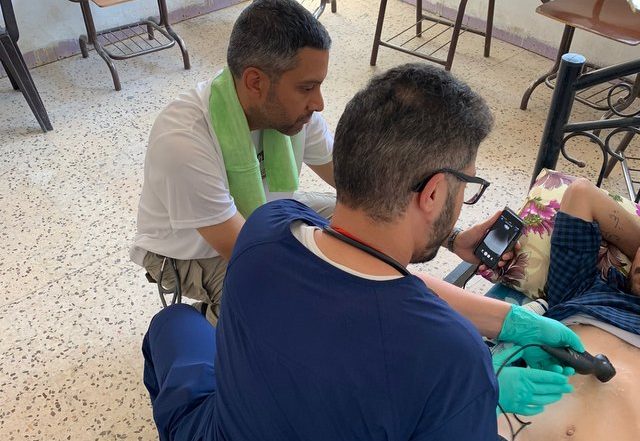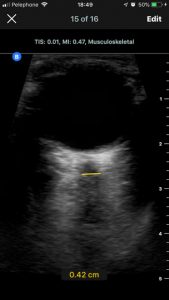Close contest in choosing best portable ultrasound device.
This review culminates our series evaluating the field testing of the three main available portable ultrasound devices—Clarius, Lumify and Butterfly iQ.
After putting the Clarius and Lumify to the test on prior international mission trips, we were eager to see if the iQ lived up to the hype. We used it during a weeklong trip to Jordan, providing medical care for refugees of the longstanding Syrian civil war. On average, throughout each 10-hour clinic day, we scanned 20 patients of all ages with a variety of chief complaints. Tested applications included: obstetric, abdominal, ocular, cardiac and trauma scans.
Specifications:
-Ultrasound-on-ChipTM technology—no piezoelectric crystals
-Image depth: 2-30 centimeters
-Dimensions: 18.5cm (length) x 5.6cm (width) x 3.5cm (height)
-Weight: 313 grams
-Lightning or USB-C cable options–comes with 1.25 meter connection cable plus wireless charging dock
-Temperature Range: won’t scan if >43°C; minimum temperature of 5°C
-Approximate scan time: 120 minutes continuous, 10-12 hours intermittent
-Recharge time: 5 hours for a full recharge
-Recently released carrying case ($99) and holster with belt clip ($49) for easier storage and portability
Pros:
-Cost: $1,999 for initial device purchase (with one-year warranty) plus subscription fee (covers software updates, unlimited storage, tutorial videos and support services) of $420 annually for one user or $1,200 annually for group rate for up to 10 users (device still works without subscription, however you can’t upload images for storage)
-One transducer for all imaging
-Lightweight and more drop-resistant than piezoelectric crystal transducers
-Good image quality, but in our experience, grainy quality with cardiac windows (slightly better when using manual time gain compensation)
-iOS/Apple compatible only—touch screen allows for rapid image modification for depth, gain, measurements and storage
-Intuitive app: fast, easy connectivity with smooth image acquisition —19 clinical presets for specific scan types
-No overheating — transducer temperature is indicated at the top of the app while you scan
-Directly connects to phone/tablet without rapid battery drainage
-Expanding Butterfly Education which features tutorial videos and image sharing
-Strong customer support — after the Jordan trip, my iQ stopped working (no noticeable hardware damage or software issues and resetting it did not help) and within one week I had a new device!
Cons:
-iQ must connect to the Internet at least once every 30 days for updates; may self-disable if this isn’t done—could negatively impact secure usage in a prolonged, remote environment
-Non-removable battery — unclear how many charges the lithium battery is good for and if the battery fails, how to replace it, short of buying a new iQ
-No Ocular preset—not approved by FDA (full disclosure: there were four cases in Jordan where we briefly used the iQ to scan for retinal detachments and vitreous hemorrhage—no other options existed for diagnosis where we were—each scan was under 30 seconds and there were no noted side effects afterwards to the patients)
-Obstetrics measurements are not available on the app—femur length, head circumference, etc. to assist in calculating an estimated gestational age
-Can’t use camera or other functions on your Apple product when iQ app is being used
-Despite the iQ website touting its secure data acquisition and transmission, we recommend users buy a separate phone/tablet just for the iQ. This is to protect personal information and possible hacking–same advice applies to Clarius and Lumify
-Connection cable is permanently attached to the transducer and vulnerable to damage or warping of the connection point—to our knowledge, there is no way to replace this cable if it gets too frayed
Final thoughts:
In terms of use in a field setting, no clear victor emerges. All three portable ultrasounds satisfy basic requirements of safety, portability and quality image acquisition. Each ultrasound has its own unique positives as well as room for improvement.
The iQ offers a price point facilitating personal ownership and combines multiple probes into one lightweight transducer. The Clarius offers a wireless transducer with top-notch customer support and excellent tutorial videos. For the occasional portable ultrasound user, Lumify’s flexible rental option is unique and we also found it had the best image quality.

The iQ cardiac imaging needs to be of higher quality, in our opinion, and they need to consider designing a way to separate the connecting cable from the transducer for safer storage. Clarius needs to address the overheating of its transducer(s) and find a way to make a smaller transducer profile, particularly for pediatric scanning. Lumify plans to expand its platform to include iOS yet needs to also improve the ease of image acquisition, modification and storage.
All three products are a remarkable advancement in point-of-care ultrasound usage and with continued refinement, could significantly expedite the delivery of care in a field setting. We encourage our readers to trial each one and form their own opinions — happy scanning!












7 Comments
Hi! One quick question. Your comparison with the Clarius was with the first or second model? I own the first generation and the overheating it’s a big downside. However, the second gen the “Clarius HD” Its watercooled. I haven’t tried it myself but i was thinking of getting one, but the butterfly sounds great to until you realized it has pottentionaly weak cord that could be torn apart or ripped if not careful and a non removable battery.
I am a retired OB-GYN, worked with ultrasound in it’s infancy. (1968, at Kings County -Downstate Medical Center, Brooklyn ).
The proto-type machine was large with a small piezo transducer attached to an articulating arm.
Over the years,ultrasound machines have evolve .
These new devices are amazing . Seems to be user friendly.
In my practice, , I scan every patient to confirm findings,this device will certainly improve patient care at point of service.The information obtained will be use immediately . Storage is not needed.
What company sells the butterfly, and is the company listed on a stock exchange? Or…..is an IPO in the offing?
Butterfly sells the Butterfly – it’s direct to consumer
Did u use it in a country that is not on the list of the company ?!? When u mentioned Jordan , you meant Jordan in the Middle East ?!?
How do these compare for a simple bladder scan measurement of residual urine?
hi. can you use the butterfly while it is charging via usb-c cord?